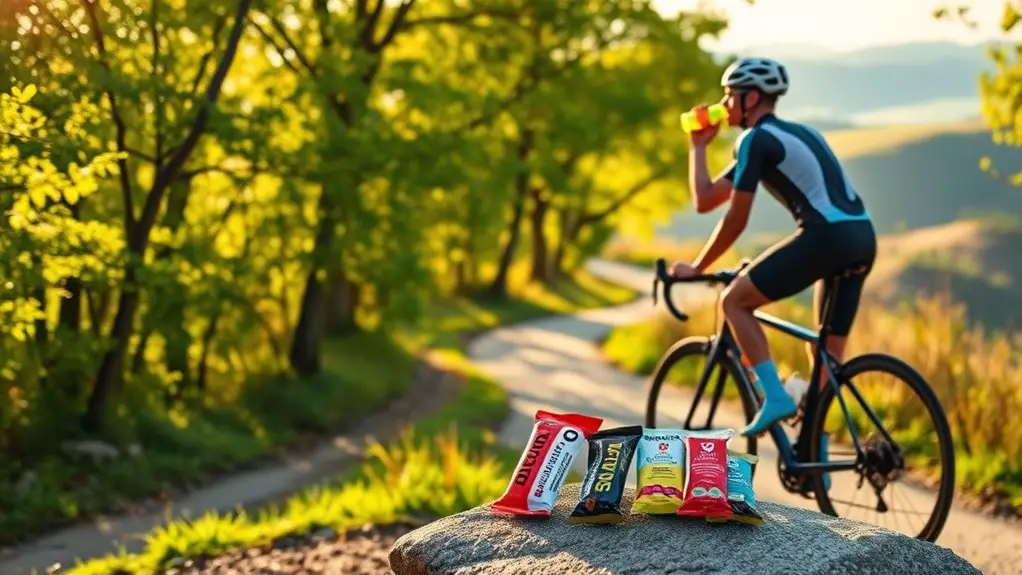To reduce fatigue during long-distance cycling, focus on proper nutrition, hydration, and pacing. Fuel up with balanced meals, including carbs for energy. Stay hydrated by sipping water and electrolyte drinks regularly. Pace yourself by starting slow and maintaining a comfortable cadence. Don't forget to incorporate breaks for recovery and mental clarity. Stretching before and after rides can help, too. If you want more tips to enhance your ride, there's plenty more to explore.
Understanding Fatigue in Cycling
When you push your limits during long-distance cycling, understanding fatigue becomes essential for improving your performance. Fatigue isn't just a feeling; it's a complex interplay of fatigue mechanisms that can hinder your ride. When you cycle for hours, energy depletion occurs, primarily due to glycogen stores running low. Your muscles need fuel, and when that runs out, your body starts to feel heavy and sluggish.
Recognizing the signs of fatigue early can empower your freedom on the road. Pay attention to your body; are your legs feeling heavier than usual? Are you losing focus? These are signals that you're approaching your limits. By understanding these mechanisms, you can better manage your ride, allowing for strategic breaks and pacing. This knowledge not only helps you ride longer but also guarantees you enjoy the journey. Additionally, maintaining proper hydration levels is crucial to sustain energy and focus throughout your cycling adventure. Embrace this understanding, and you'll find that freedom in cycling becomes even more exhilarating.
Importance of Proper Nutrition
Proper nutrition plays an essential role in combating fatigue during long-distance cycling, as it fuels your body and supports peak performance. To keep your energy levels up and feel free on those long rides, consider these key nutrition strategies:
- Carbohydrate Loading: Prior to your ride, increase your carbohydrate intake to maximize glycogen stores. This gives you the energy you need for those grueling miles ahead.
- Nutrient Timing: Pay attention to when you eat. Consuming the right nutrients before, during, and after your ride can help maintain energy levels and speed recovery.
- Balanced Meals: Focus on a mix of carbs, proteins, and healthy fats in your meals. This balanced approach will keep your body fueled and ready to tackle any challenge on the road. Additionally, proper hydration strategies are crucial for maintaining endurance and preventing fatigue during long rides.
Staying Hydrated on Long Rides
Staying hydrated during long rides is essential for maintaining your energy and preventing fatigue. To embrace the freedom of the open road, you need to explore effective hydration methods. Water's great, but it's not always enough. Consider adding electrolyte-rich drinks to your routine; they help maintain your electrolyte balance, especially on hot days or during intense rides.
Carry a water bottle or hydration pack, and sip regularly rather than waiting until you're thirsty. Set reminders if needed—your body might not signal dehydration until it's too late. Proper hydration supports optimal performance during your rides, allowing you to push through fatigue more effectively.
Experiment with different hydration methods to find what works best for you. Some cyclists prefer electrolyte tablets, while others swear by sports drinks. Listen to your body and adjust your intake based on the ride's intensity and duration. With proper hydration, you'll feel more vibrant and ready to conquer those miles ahead, ensuring each ride is a liberating adventure.
Pacing Strategies for Endurance
While it might be tempting to start strong and push hard right from the beginning, effective pacing is critical for endurance in long-distance cycling. Mastering your effort helps you enjoy the ride without burning out too soon. Here are three key strategies to help you maintain your stamina:
- Cadence Control: Aim for a consistent cadence that feels comfortable. Find that sweet spot where your legs work efficiently without overexerting.
- Monitor Your Heart Rate: Keep your heart rate in check. Staying within a target zone guarantees you're not pushing too hard early on, which can lead to fatigue.
- Gradual Increases: Start at a manageable pace and gradually increase your intensity. This approach allows your body to adapt and helps you maintain energy for the long haul. Interval training can also be incorporated into your cycling routine to enhance overall endurance.
Incorporating Rest and Recovery
When you're tackling long distances, incorporating scheduled breaks is essential for maintaining your energy levels. Active recovery techniques can also help rejuvenate your muscles and keep you feeling strong throughout your ride. By prioritizing rest, you'll set yourself up for better performance and less fatigue. Additionally, embracing rest days is key to accessing true potential on your cycling journey.
Importance of Scheduled Breaks
Incorporating scheduled breaks during long-distance cycling isn't just a luxury; it's essential for maintaining your energy levels and preventing fatigue. By planning break intervals, you'll recharge both physically and mentally, enhancing your overall experience on the road. Here's why scheduled rest matters:
- Energy Restoration: Short pauses help replenish glycogen stores, keeping your legs fresh.
- Mental Clarity: Taking time to step back allows you to refocus, making your ride more enjoyable.
- Injury Prevention: Regular breaks reduce the risk of overuse injuries, letting you ride longer and stronger.
Active Recovery Techniques
Scheduled breaks are a great start, but incorporating active recovery techniques can further enhance your cycling endurance. Instead of just sitting back, consider light activities that keep your muscles engaged while allowing them to recover. Try gentle stretching, walking, or even yoga to promote blood flow and flexibility. These recovery techniques can help reduce muscle soreness and prepare you for your next ride. You might also find benefits in low-intensity cycling or swimming—perfect for keeping the spirit of freedom alive while resting your legs. Remember, active recovery isn't just about reducing fatigue; it's about rejuvenating your body and mind, empowering you to ride longer and enjoy every moment on the road.
The Role of Stretching and Mobility
When it comes to long-distance cycling, flexibility plays a vital role in reducing fatigue. Incorporating a pre-ride mobility routine can help you prepare your body for the demands ahead. By focusing on stretching and mobility, you can enhance your performance and enjoy a more comfortable ride. Additionally, improving your range of motion can facilitate efficient movement and further reduce the risk of fatigue during long rides.
Importance of Flexibility
Although many cyclists focus on endurance and strength training, flexibility plays an essential role in reducing fatigue during long-distance rides. Incorporating flexibility exercises and dynamic stretching into your routine can enhance your performance and comfort on the bike. Here's why you should prioritize flexibility:
- Improved Range of Motion: Enhanced flexibility allows for smoother pedaling and better bike handling, reducing strain on your muscles.
- Injury Prevention: Flexibility exercises help keep your muscles balanced and less prone to injury, allowing you to ride longer.
- Enhanced Recovery: Stretching helps release tension, promoting faster recovery after those epic rides, so you're ready for the next adventure.
Embracing flexibility will give you the freedom to ride longer and enjoy every moment on the road.
Pre-Ride Mobility Routine
Before you hit the road, incorporating a pre-ride mobility routine can considerably enhance your cycling experience. Start with dynamic stretching to wake up your muscles and improve your range of motion. Think leg swings, arm circles, and hip openers—movements that get your blood flowing and joints ready for action. Don't forget about foam rolling, either; it's a fantastic way to release tension and prepare your body for the ride ahead. Spend a few minutes rolling out tight spots, especially in your quads, hamstrings, and calves. This routine not only reduces the risk of injury but also keeps you feeling free and fluid on your bike. So, carve out that time; your body will thank you as you conquer the miles.
Mental Strategies to Combat Fatigue
As you tackle long distances on your bike, maintaining a strong mental state can be just as essential as physical endurance. Here are a few strategies to keep your mind sharp and focused:
- Mental Visualization: Picture yourself conquering challenging terrains and crossing the finish line. This technique can help you stay motivated and overcome mental barriers.
- Positive Affirmations: Repeat empowering phrases like "I'm strong enough" or "I can do this" to reinforce a positive mindset. The more you believe in your abilities, the less fatigue will weigh you down.
- Break It Down: Instead of fixating on the total distance, break your ride into smaller segments. Celebrate each milestone, and you'll find joy in the journey rather than just the destination. Additionally, incorporating positive self-talk can significantly influence your performance and resilience during long rides.
Embrace these mental strategies, and you'll reveal a newfound freedom on your long rides, making fatigue a thing of the past.
Gear and Equipment Tips for Comfort
Staying mentally sharp during long rides is important, but having the right gear can greatly enhance your overall comfort and performance. Start with saddle selection—choose one that fits your riding style and body shape. A proper bike fit is vital; make certain your handlebar height aligns with your comfort level. Clothing materials matter too; opt for breathable fabrics that wick away moisture, keeping you cool.
When it comes to pedals, verify your choice matches your shoe compatibility for a secure connection. Don't overlook tire pressure; the right inflation can make a huge difference in ride quality. Finally, consider your gear ratios; having the right setup helps you tackle inclines with ease, reducing fatigue. Additionally, remember to replenish your electrolyte levels to maintain stamina and prevent fatigue during long rides. With these adjustments, you'll feel free to roam the open road, enjoying every mile without discomfort.
Frequently Asked Questions
What Are the Signs of Overtraining in Cyclists?
When your body feels like a deflated balloon, it might be time to pay attention. Overtraining symptoms in cyclists often include persistent fatigue, decreased performance, and mood swings. You've gotta listen to your body! Recovery strategies like rest days, proper nutrition, and adequate sleep can help you bounce back. Embrace the freedom of recovery; it's part of the journey. Remember, even the strongest cyclists need a break to recharge and soar again.
How Can Weather Conditions Impact Cycling Fatigue?
Weather conditions can seriously impact your cycling experience. High humidity effects can make you feel sluggish, as your body struggles to regulate temperature. On the other hand, temperature extremes can lead to heat exhaustion or hypothermia, draining your energy. Staying aware of these factors allows you to plan your rides better, helping you maintain that sense of freedom you crave while cycling. Embrace the ride, but respect the weather's influence on your performance!
Should I Cycle When Feeling Fatigued?
Imagine your body as a finely-tuned engine. When it's running low on fuel, pushing it harder could lead to breakdown. So, if you're feeling fatigued, listen to that inner mechanic. It's essential for fatigue management to prioritize cycling recovery over pushing through. Your freedom on the bike depends on your ability to recharge. Sometimes, resting is the key to releasing greater rides ahead, allowing you to ride strong and free when the time's right.
What Are the Benefits of Cross-Training for Cyclists?
Cross-training's a game-changer for cyclists like you. It boosts your overall strength, making your rides more efficient. Strength training builds muscle endurance, helping you power through tough terrains. Plus, incorporating yoga benefits flexibility and balance, reducing the risk of injuries. You'll feel more liberated on your bike, with improved stamina and recovery. Embrace these activities; they'll enhance your cycling experience and keep you feeling fresh and ready for the next adventure!
How Does Body Weight Affect Cycling Performance?
When you think about how body weight affects cycling performance, consider your power to weight ratio. A lower body weight, combined with maintaining muscle mass, can enhance your efficiency and speed. Aiming for ideal body composition allows you to climb hills easier and sustain your pace longer, giving you more freedom on longer rides. Balancing strength and weight isn't just about losing pounds; it's about finding that sweet spot for peak performance.




